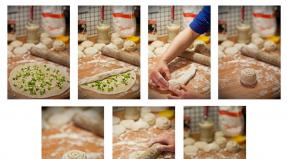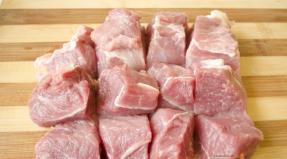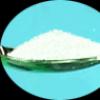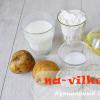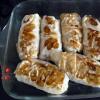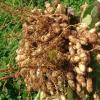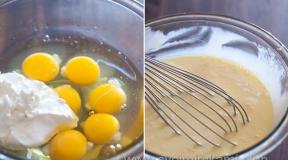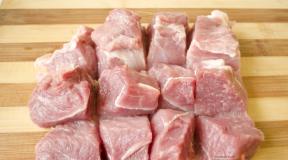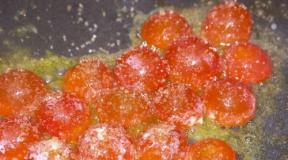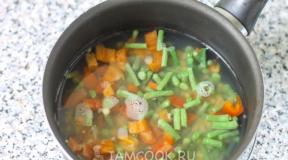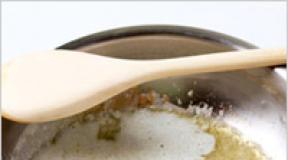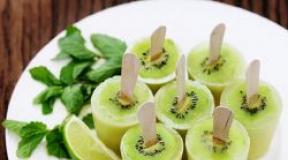The fastest Easter cake dough recipe. How to bake Easter cake - recipes for Easter
Not only Easter appears, but also the illuminated Easter cake. Quite often in the old days, a lot of dough was prepared for Easter cakes, since larger volumes of Easter cake dough ferment better. But unlike ordinary pie dough, where chefs do not recommend putting eggs, in real cake dough, against all odds, they put from 5 to 7 eggs, beaten into a foam before mixing. The basis of the products is a high protein content, a lot of butter and a large amount of sugar.
These components will allow any cook to get what she needs, and with an increase in the number of eggs, ready-made eggs will only last longer, while almost not becoming stale. A large number of different recipes have been created, and you can always find a huge number on the Internet. But all culinary specialists agree on one opinion - for Easter cake, not only the content, but also the form is important. It is worth noting that the shapes for Easter cakes can be completely different.
Since soft cakes are most often prepared from yeast dough, the yeast must be fresh only, and it is not recommended to immediately overload the dough with baked goods. That is why Easter Easter cake dough is prepared in several steps at once, which are classified into the gradual introduction of oil, then a large number of eggs, and, finally, sugar. You will have to nurse and nurture the dough for a very long time. In addition, chefs recommend not exposing the Easter cake dough to drafts, but rather placing it in a warm, dark place and covering it with pillows.
As a rule, after a person has learned an easy recipe for Easter cakes, he does not think about the future taste and does everything at once. But the dough for Easter cakes must be mixed on the night from Thursday to Friday, so that Easter cakes can be baked from it the entire next day. Usually, on the night from Saturday to Sunday, Easter cakes are blessed, and they treat each other only in the morning. Easter cakes can be eaten throughout Easter week, right up to Radonitsa. When baking Easter cakes, it is necessary to use special metal low cylindrical molds made of universal thick tin. Thus, by moistening the inner surface with oil, preparing a delicious Easter cake will not be difficult.
You can also use ordinary metal aluminum pans with a total volume of 1-1.5 liters, but no more. If you use taller and more voluminous dishes when cooking, then in a gas or electric stove such dough may not only fail to bake, but also become soggy or dry out. In the old days, small Easter cakes were often made in special bucket shapes. Easter cakes were quickly baked in them, almost the same as in a Russian oven. Below is an easy, time-tested Easter cake recipe.
Easy Easter cake recipe
To prepare this dish we will need 1 kg of high-quality flour, 2 glasses of fresh milk, 5-6 chicken eggs, 500 g of butter, about 3 glasses of sugar and 200 g of yeast. For decoration we use candied fruits and vanillin.
First you need to knead the dough. To do this, we begin to dissolve the yeast in warm milk, and at the same time add half a kilo of flour. Cover this batch and place in a warm place for about an hour. Then add the yolks, which were previously beaten with sugar, and a small amount of vanillin. After this, you should gradually pour in the melted butter and gradually mix everything.
When the dough begins to rise, you need to add washed and dried candied fruits and nuts to the dough and mix everything thoroughly. The dough is laid out in molds, and the dough is placed in a hot oven at a temperature of 300-300 degrees for an hour. After that, all that remains is to look after it and decorate the dish after cooking.
I hope that after my article you understand how to prepare this dish using an easy Easter cake recipe.
The cake is prepared using the sponge method using fresh pressed yeast and milk using butter. It is this that will give the dense butter dough that friability, which is why we love Easter cakes. In addition, cinnamon is added to baked goods. For those who prefer vanilla flavor, simply replace the cinnamon powder with a packet of vanillin.
simple cake recipe
Ingredients:
For the test:

- 500 grams of premium flour;
- 180 ml milk (3.2% fat);
- 250 grams of sugar;
- 2 chicken eggs;
- 1 chicken yolk;
- 18 grams of pressed fresh yeast;
- 180 grams of butter (82% fat);
- one teaspoon each of turmeric and cinnamon powder;
- a pinch of salt;
- a pinch of vanillin for aroma;
For decoration:

- 100 grams of powdered sugar;
- 40 ml milk;
- colored powder.
Cooking process:
 First prepare the dough. To do this, the milk should be slightly warm; fresh yeast will need to be crumbled into it.
First prepare the dough. To do this, the milk should be slightly warm; fresh yeast will need to be crumbled into it.
 Sweeten the milk mixture a little and add about 2 tablespoons of flour.
Sweeten the milk mixture a little and add about 2 tablespoons of flour.  To make the dough foam, cover it with a towel and place it in a place without drafts. It is advisable that it stands close to the oven that is turned on. It will still need to be preheated before baking the cakes themselves. After 30 minutes the dough will foam and you can continue working with it.
To make the dough foam, cover it with a towel and place it in a place without drafts. It is advisable that it stands close to the oven that is turned on. It will still need to be preheated before baking the cakes themselves. After 30 minutes the dough will foam and you can continue working with it.
 While the batter is fermenting, you will work on the buttery part of the Easter cakes. For this we need 2 chicken eggs and one yolk. Add sugar to them and start beating with a mixer at maximum speed until the eggs turn white.
While the batter is fermenting, you will work on the buttery part of the Easter cakes. For this we need 2 chicken eggs and one yolk. Add sugar to them and start beating with a mixer at maximum speed until the eggs turn white.
 Add the sifted flour and knead the dough.
Add the sifted flour and knead the dough.
 Melt the butter and add it while warm to the dough.
Melt the butter and add it while warm to the dough.
 Add a little salt. The mass will become fat and obedient.
Add a little salt. The mass will become fat and obedient.
 Now combine the sponge yeast and butter parts of the dough.
Now combine the sponge yeast and butter parts of the dough.
 Add turmeric and cinnamon to give the dough a nice color.
Add turmeric and cinnamon to give the dough a nice color.
 Add vanilla. Once again, forget about the dough for about 1-1.5 hours. During this time, it will rise 2-3 times, and you can bake Easter cakes from it.
Add vanilla. Once again, forget about the dough for about 1-1.5 hours. During this time, it will rise 2-3 times, and you can bake Easter cakes from it.
 Fill the baking pans exactly halfway with the dough, as it will rise to the top during baking. I usually line metal pans with oiled baking paper to help the cakes come out of the pans easily.
Fill the baking pans exactly halfway with the dough, as it will rise to the top during baking. I usually line metal pans with oiled baking paper to help the cakes come out of the pans easily.
 Bake the Easter cakes for 30-40 minutes at an oven temperature of 180 degrees.
Bake the Easter cakes for 30-40 minutes at an oven temperature of 180 degrees.
Leave the finished golden brown cakes to cool on the table.

 Make a glaze from powdered sugar and milk and pour it over the tops of your heads. Sprinkle them with confectionery sprinkles.
Make a glaze from powdered sugar and milk and pour it over the tops of your heads. Sprinkle them with confectionery sprinkles.
Festive golden cake with turmeric is ready!
Happy holiday to everyone and bon appetit!

Homemade fragrant Easter cakes cannot be compared to store-bought ones. If you don’t have time, but want to cook Easter cakes, use interesting recipes.
This is a fragrant yeast cake with candied fruits and raisins. Cooking time: 4 hours, yields 10 servings. Calorie content – 4500 kcal.
Ingredients:
- 300 ml. milk;
- 600 gr. flour;
- 4 eggs;
- 1/2 cup Sahara;
- 30 gr. yeast;
- 150 gr. ;
- 100 gr. candied fruits and raisins;
- a packet of vanillin.
Preparation:
- Mix 2 tablespoons of warm milk with yeast, add 1 tsp. sugar and flour. Place in a warm place for 15 minutes.
- In a large bowl, sift the flour, add the remaining milk and the prepared dough. Make the dough and put it in a warm place for 1.5 hours.
- Beat the yolks with sugar, put the whites in the refrigerator.
- Pour the yolks and melted butter into the dough, add candied fruits and raisins. Place in a warm place for an hour.
- Divide the risen dough halfway into the molds and let stand for a while.
- Bake at 180°C for about an hour.
Decorate the finished delicious simple Easter cakes to taste and cut them when cool.
Simple Easter cake without butter
This simple recipe does not include butter. But despite this, Easter turns out delicious and lush. This makes 5 servings, which is 2400 kcal.
Ingredients:
- 3 eggs;
- 1/2 cup cream 20% fat;
- 350 gr. flour;
- 1/2 cup Sahara;
- 25 gr. trembling;
- 1/2 cup raisins;
- salt.
Preparation:
- Dissolve yeast in 1/2 cup milk and add 1 spoon of sugar and 2 spoons of flour. Leave it to come.
- Beat 2 eggs and 1 yolk, add a pinch of salt and the rest of the sugar.
- Pour the eggs into the prepared dough and stir.
- Add a glass of flour and cream to the dough. Knead the dough.
- Add flour, knead the dough again. The dough will turn out runny.
- Cover the dough with film and a towel and leave it warm for an hour and a half.
- When the dough rises, add the raisins and stir.
- Spread the dough halfway into the molds and let rest for another half an hour.
- Bake for an hour in the oven at 180°C.
Ingredients:
- 1/2 tsp. soda;
- 1 stack fermented baked milk;
- 1.5 stack. flour;
- 1 stack ;
- 1 stack raisins;
- 1 tsp loosened;
- a pinch of vanillin.
Preparation:
- Dissolve baking soda and baking powder in fermented baked milk.
- Add vanillin, sugar, flour and washed raisins to the fermented baked milk.
- Mix the dough and place it in the mold.
- Place the Easter cake into the preheated oven and bake for 40 minutes.
This makes 1 Easter, which can be divided into 7 servings.
Simple Easter cake with kefir
This delicious and simple recipe makes the cake fluffy and soft. Prepared with yeast and kefir. Cooking will take 3 hours.
Preparation:
- Pour the yeast with warm kefir, add sugar and vegetable oil.
- Add a glass of flour and stir. Leave the dough in a warm place for 40 minutes.
- When the dough is ready, add the yolks at room temperature.
- Add butter and a pinch of salt to the dough, add flour.
- Knead the dough and add raisins. Place in a warm place for an hour.
- Divide the dough into parts and place in greased molds so that the dough takes up 1/3. Keep warm for 15 minutes.
- Place the molds on a baking sheet with a thick bottom and bake for half an hour in the oven at 190°C.
Makes 5 small cakes, each for 4 servings. Calorie content – 5120 kcal.
Kulich is a traditional pastry that is prepared before Easter. Fragrant, glazed and decorated – no holiday tea party is complete without it. A simple recipe for making delicious Easter cake at home.
Ingredients:
- white wheat flour – 4 tbsp;
- sugar for dough - 8 tbsp. l;
- powdered sugar for glaze - 8 tbsp. l;
- butter – 8 tbsp. l;
- eggs – 8 pcs;
- yeast (live) - 20 g (it is preferable to use live yeast, but if you don’t have it, then replace it with 7 g of dry yeast. Often this is exactly one small bag);
- salt – 0.5 tsp;
- milk 3.2% fat - 1 tbsp;
- dried fruits/nuts – 1 tbsp (you can take any dried fruits of your choice. Chop large pieces).

 Heat the butter until soft. Add it at the end of kneading and mix thoroughly. Cover the container with the dough and leave it in a warm place to rise for 60 minutes.
Heat the butter until soft. Add it at the end of kneading and mix thoroughly. Cover the container with the dough and leave it in a warm place to rise for 60 minutes. 
 Chop the dried fruits and nuts you chose for the filling and roll in flour. Leave small dried fruits such as raisins whole.
Chop the dried fruits and nuts you chose for the filling and roll in flour. Leave small dried fruits such as raisins whole. 
 When the dough has rested for 60 minutes and has risen well, add the prepared dried fruits. Stir until the filling is evenly distributed.
When the dough has rested for 60 minutes and has risen well, add the prepared dried fruits. Stir until the filling is evenly distributed. 
 Prepare baking dishes. Line the bottom and sides with parchment. The edges of the parchment should be higher than the sides of the pan. Soften the butter and grease the inside of the parchment with it so that the finished cakes do not burn. Fill the molds 3/4 full with dough.
Prepare baking dishes. Line the bottom and sides with parchment. The edges of the parchment should be higher than the sides of the pan. Soften the butter and grease the inside of the parchment with it so that the finished cakes do not burn. Fill the molds 3/4 full with dough. 
 Let the dough rise a little. Preheat the oven to 180 degrees and place future Easter cakes in it. Bake for 40 minutes. Check readiness with a wooden stick. It shouldn't be wet. Release the finished products from the mold and leave on a wire rack to cool.
Let the dough rise a little. Preheat the oven to 180 degrees and place future Easter cakes in it. Bake for 40 minutes. Check readiness with a wooden stick. It shouldn't be wet. Release the finished products from the mold and leave on a wire rack to cool. 
 Prepare the glaze. To do this, mix powdered sugar and 6 egg whites in a bowl and beat with a mixer until stiff peaks form.
Prepare the glaze. To do this, mix powdered sugar and 6 egg whites in a bowl and beat with a mixer until stiff peaks form. 
 Use the icing to decorate the cakes to your liking. You can use a pastry syringe, colored beads, chocolate chips, and mastic figures.
Use the icing to decorate the cakes to your liking. You can use a pastry syringe, colored beads, chocolate chips, and mastic figures. 

Every holiday has traditional dishes. It’s hard to imagine the New Year’s menu without Olivier, and on March 8th - without Mimosa salad. Likewise, the Easter table is traditionally decorated with colored eggs, Easter cake and Easter cottage cheese. A good housewife will never ask where to buy Easter cake. She herself will happily tell you how to bake Easter cake, and in more than one way.
A little history
Easter, like any other holiday, has its own story, which tells the origin of its symbols and explains their meaning. Kulich is a round-shaped butter bread that decorates the Easter table. It was baked precisely round, because the shroud of Jesus Christ had a similar shape. Kulich must certainly be rich, because according to legend, before the death of Jesus, he and his disciples ate unleavened bread, and after the miraculous resurrection they began to eat yeast bread (leavened). Since then, it has become a custom to make dough for Easter cakes.

When planning to make your own Easter cake, take note of a few tips:
- the butter should not be hard, then the cake will be soft and tender;
- the butter should soften on its own at room temperature, not when heated;
- you can use paper molds made specifically for baking Easter cakes;
- You can use a tin can as a form. But in this case it must be lined with oiled baking paper;
- baking paper can be replaced with the usual one used in offices. But it must be properly lubricated with oil;
- To prevent the dough from sticking to your hands, moisten them with water or vegetable oil;
- The readiness of the Easter cake is checked with a splinter or a thin skewer, which is stuck into the Easter cake. If it is dry, the cake is ready;

Easter Kulich traditional
- 1 kg of wheat flour;
- 6 eggs;
- 1.5 glasses of milk;
- 300 gr. margarine (or butter);
- 1.5 cups sugar;
- 40 gr. yeast;
- dried fruits and nuts (150 grams of raisins, 50 grams of candied fruits and almonds).
- 0.5 packets of vanilla sugar;
- salt;
Preparation:
- Lightly heat the milk and dissolve the yeast in it.
- Add half of the indicated portion of flour. Stir. The dough is ready.
- Cover the bowl with the dough with a towel and place in a warm place.
- The dough should be left to rise until its volume doubles.
- Separate the yolks and whites. Beat the yolks with vanilla and sugar, beat the butter.
- Add salt, yolks and butter to the dough. Mix everything.
- Beat the egg whites until they form a thick, elastic foam. Add them to the dough.
- Add the remaining flour. The resulting dough should freely lag behind the walls of the dish. It should not be too steep and well kneaded.
- Cover the dough again and leave in a warm place until it has doubled in size.
- Wash the raisins, dry, roll in flour. Cut the candied fruits into squares. Peel the nuts and chop them. Add dried fruits and nuts to the risen dough.
- Prepare a mold (with a round bottom!): line the bottom with oiled baking paper, grease the sides with butter and sprinkle with flour. Fill the form 1/3 full with dough.
- Leave the dough to rise. It will be ready to go into the oven when it has risen halfway up the pan.
- The oven should not be too hot. Leave the mold in it for 50 minutes to 1 hour. Carefully rotate the pan as it bakes. If the top browns early, cover it with paper soaked in water to prevent it from burning.
Decorate the finished cake with chocolate, candied fruits or nuts.

Quick cake
Many housewives, especially those busy at work or with small children, are concerned with the question of how to bake Easter cakes with the least amount of time. The recipe below is easy to prepare and saves effort.
You will need:
- 1 glass of milk;
- 4 eggs;
- 1 tbsp. l. dry yeast (or 50 grams of fresh);
- 1 cup of sugar;
- 2 tbsp. l. vegetable oil;
- 100 gr. butter;
- 3 cups flour;
- vanillin;
- raisins, candied fruits.
Preparation:


- Warm the milk.
- Add yeast and sugar (only 1 tbsp) to warm milk. Stir and leave for 15 minutes so that they “make friends.”
- Beat the eggs with the remaining sugar and vanilla.
- Melt the butter and add it to the dough. Add vegetable oil, yeast and stir well.


- Add washed and dried raisins and candied fruits.
- Gradually stir in the sifted flour. The dough should be pourable.
- Divide the dough into the molds. It will rise, so the dough should take up no more than 1/3 of the mold.
- Leave the dough in the molds for 3-4 hours - during this time you can get down to business.


- Place the molds in a hot oven (t=180 degrees). Bake the cake until done.
- Decorate the finished cake with icing and confectionery beads.

Easter cake without yeast and eggs
There are a lot of recipes on how to bake a delicious Easter cake. It turns out that it can be prepared without yeast, milk and eggs.
You will need:
- 240 gr. flour;
- 2 tsp. baking powder;
- 0.5 cups brown sugar;
- 1 banana;
- 40 ml juice (pineapple);
- 180 ml water;
- 50 gr. raisins;
- salt;
- 3 tbsp. l. vegetable oil.
Preparation:
- Mash the banana to make a puree.
- Add oil, water, juice. Stir.
- Add salt (a pinch) and baking powder.
- Gradually sift the flour into the dough, stirring it constantly.
- Knead into a sticky dough.
- Fill the molds with it so that the dough occupies 3/4 of the volume of the mold.
- Bake the cake in the oven preheated to 200 degrees for about 50 minutes. The time depends on the oven.
- The finished cake should be removed from the mold when it has cooled. Decorate it with icing and other decorations.

The beauty of making your own Easter cake is that homemade Easter cake can be prepared not only according to the traditional recipe, but also using, for example, sour cream.
You will need:
- 200 gr. sour cream;
- 1 tsp. dry yeast (or 25 g fresh);
- 170 ml milk;
- 50 gr. butter;
- 150 gr. Sahara;
- 650-700 gr. flour;
- 3 eggs;
- 2-3 tbsp. l. cognac or rum;
- 50 gr. raisins;
- nuts for sprinkling;
- vanillin.
Preparation:
- Pour rum or cognac over the raisins.
- Dilute the yeast with some warm milk - pour 2 tbsp. l. milk, they will come in handy later.
- Separate the white from the yolk in one egg. Beat two eggs and the white of the third with sugar and sour cream.
- Combine everything in one bowl, stir, add salt and gradually add flour.
- The dough should be soft and slightly sticky. Cover it with a towel and leave for half an hour.
- After half an hour, add soft butter to the dough and stir. Cover again with a towel and leave for one and a half to two hours.
- Knead the dough lightly and add the squeezed raisins. Knead the dough so that the raisins are evenly distributed throughout the dough.
- Divide the dough into the molds and leave until doubled in size.
- Mix the yolk with 2 tbsp. l. milk and brush the top of the cake with the mixture. Chop the nuts and sprinkle them on the cake.
- Place in the oven (t=200 degrees) for 30 minutes until done.

Decorations help make the cake truly festive: icing, marmalade, multi-colored confectionery beads, nuts, marzipan, candied fruits, fruit figures. When talking about Easter cake, one immediately thinks of lush round bread with a white top. This is the icing. The following recipe answers the question of how to make icing for Easter cake.
You will need:
- 1 egg white;
- 100 gr. sugar (fine);
- salt (pinch).
Preparation:
- Cool the whites and beat with salt until elastic foam is obtained.
- Without stopping whisking, add sugar.
- Continue beating for another 4 minutes after the sugar runs out.
- When the cake has cooled slightly, spread the glaze on it and leave until hardened.
Easter dishes prepared with your own hands not only give a great taste and delight with a festive appearance, but also carry a positive charge, being filled with feelings and good wishes of the hostess.
